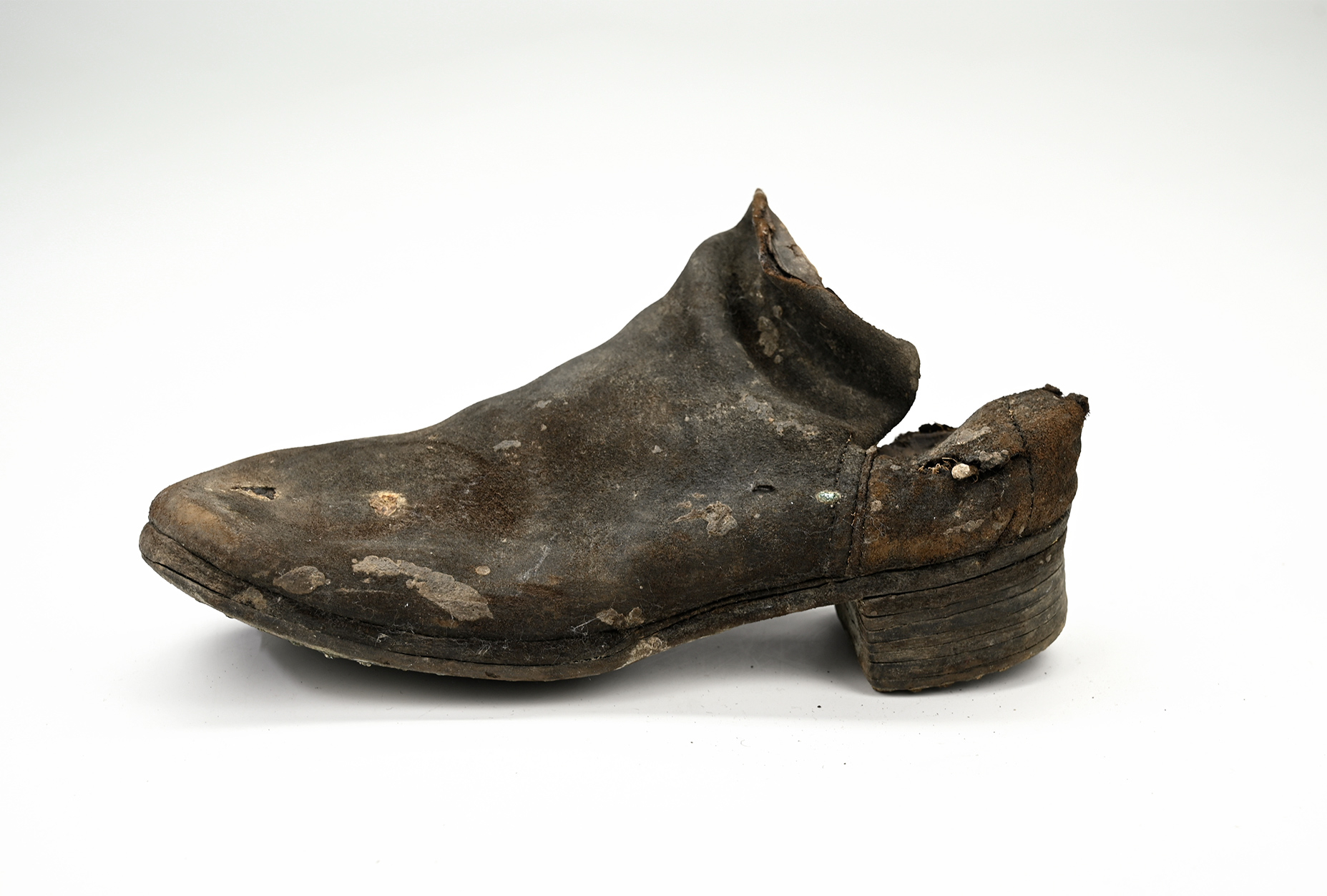site search
online catalog
SCARCE US CAVALRY M1872/76 BOOT SALVAGED OR ALTERED BY SOLDIER TO BARRACKS SHOE

$295.00 SOLD
Quantity Available: None
Item Code: 1052-289
This is a US Army issue cavalry boot with the leg cut down to salvage the leather for another purpose or to alter it for wear as a barracks or camp shoe, something the army did not think about issuing until the mid-1880s. The boot shows the uses of brass screws for attaching the sole and a side seam, identifying it as a Model 1872 or 1876, which differed only slightly in the height and circumference of the leg.
The shoe is solid. The leather is stiff and a dusty brownish black with stains, but shows the correct rough-side-out construction. The nailed heel and brass screwed sole are firmly in place, with the nail and screw heads showing corrosion. The sole shows wear, but no holes, so it must have been discarded for some other reason. The forepart of the boot was trimmed to curve over the top of the foot. The rear, at the ankle is partially there, with ragged edge on the left and missing on the right. It is possible the soldier had earlier disposed of the leg portion of a pair of boots and wore them as shoes before discarding them. From 1879 to 1883 regulations were very loose about footgear, leading to complaints from officers who wanted some uniformity, with the matter only resolved by orders to wear issue footgear when on duty.
This comes from excavations (on private property with the owner’s permission) at Fort Pembina, ND, and was preserved in relatively good condition due to the anaerobic, wet conditions of the dig, which has produced both leather gear and even cloth in remarkable states of preservation. (Think of the excellent condition Roman army finds from similar soil conditions in Britain.) It compares in condition to the attic or barn finds collectors used to make “back in the day.”
Fort Pembina was situated in the Red River Valley in North Dakota near the Canadian border. Trading posts existed earlier in the area as part of the fur trade, and the first U.S. military post there was temporary- manned by a detachment of Minnesota troops in 1863-1864 following the 1862 Sioux uprising. In March 1870 a new fort was established south of the Pembina River and about 200 yards west of the Red River, completed by July and named in honor of Gen. George H. Thomas. The name was changed to Fort Pembina in September and the initial garrison consisted of two companies of the 20th US Infantry. Their main purpose was to provide security for settlers worried about Sioux returning south from Canada, but much of their duty involved escorting boundary surveys along the Canadian border and preventing Fenian raids heading north into Canada.
The fort included enlistedmen’s barracks, officers’ quarters, guard house, ordnance storehouse, company kitchen, root house, laundress’s quarters, quarters for civilian employees, hospital and hospital servant’s house, a barn for the “hospital cow,” quartermaster and commissary offices and storehouse, stables, wagon shed, etc. The garrison reached peak strength in 1878 of 200, but the average was about 125 enlisted men and 8 officers. An October 1885 return listed 97 men, 2 field pieces, 1 mountain howitzer, 100 rifles, 19 pistols, 23 mules, and 9 wagons. By 1890 the post had just 23 men, and after an 1895 fire destroyed some 19 buildings it was decided to abandon the fort rather than rebuild, the last detachment left in September. The property was turned over to the Interior Department and later sold in 1902.
Any early US army shoes or boots are scarce- they were hardly the sort of thing to be preserved by a soldier for sentimental reasons or treasured as a family heirloom. Nevertheless, they were an essential piece of gear and this one has a solid connection to the frontier army. It is also nice example of how a soldier modified a government issue item for personal comfort and practicality, or salvaged what he could for other purposes at a remote frontier post. [sr] [ph:m]
~~~~~~~~~~~~~~~~~~~~~~~~~~~~~~~~~~~
THIS ITEM, AS WITH ALL OTHER ITEMS AVAILABLE ON OUR WEB SITE,
MAY BE PURCHASED THROUGH OUR LAYAWAY PROGRAM.
CLICK HERE FOR OUR POLICIES AND TERMS.
THANK YOU!
Inquire About SCARCE US CAVALRY M1872/76 BOOT SALVAGED OR ALTERED BY SOLDIER TO BARRACKS SHOE
For inquiries, please email us at [email protected]
Most Popular
Historical Firearms Stolen From The National Civil War Museum In Harrisburg, Pa »
Theft From Gravesite Of Gen. John Reynolds »
Cavalry Carbine Sling Swivel »
Fine Condition Brass Infantry Bugle Insignia »
featured item
12-POUNDER NAPOLEON PENDULUM HAUSSE CANNON SIGHT
This is an essential piece of artillery gear for crews manning the classic Civil War field-piece, the Model 1857 12-Pounder Napoleon. The pendulum hausse rear sight was the often-used replacement for the tangent scale rear sight that needed the… (1231-02). Learn More »




